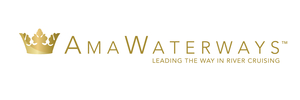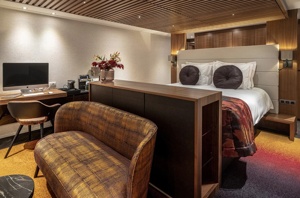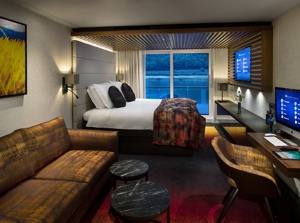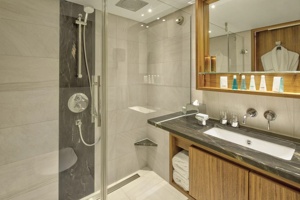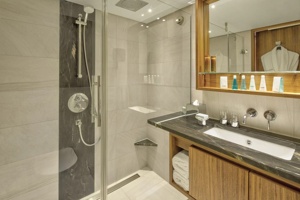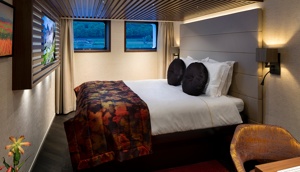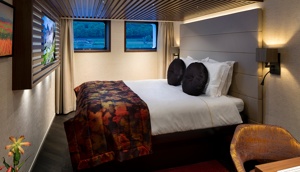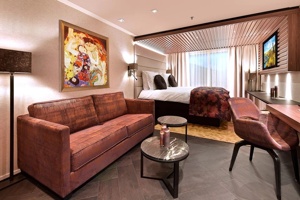As imagined by AmaWaterways' Co-Founder, Co-Owner and President Rudi Schreiner, the “Godfather of River Cruising,” the one-of-a-kind AmaMagna is the flagship of our award-winning river fleet. Twice the width of traditional European river ships and offering the luxury of space, four unique dining venues and more leisure opportunities, the innovative AmaMagna has redefined the river cruise experience! Most accommodations are spacious suites measuring 355 to 710 sq. ft. with full balconies.
In addition to the Main Restaurant and The Chef's Table, AmaMagna offers Jimmy's, a family-style restaurant named for AmaWaterways' late Co-Owner Jimmy Murphy, and the intimate Al Fresco Restaurant, serving up delicious vegetable-forward fare. Both a sun-deck pool and whirlpool invite guests to refresh and enjoy the views, while AmaMagna's Zen Wellness Studio is an expansive space with a fitness center, two massage rooms and a refreshing juice bar. A brand-new full-size pickleball court will also be featured on the Sun Deck, debuting in 2023. With connecting staterooms and triple/quadruple accommodations available, AmaMagna is also the perfect river cruise ship for families and groups!
Cruise ID: 51483
Explore Europe's amazing sights like the locals do. We were the first river cruise line to carry an entire fleet of complimentary bicycles on board, so you can experience biking alongside enchanting riverside pathways and in city centers. Whether you feel like joining one of our exclusive guided bike tours, or want to go discover on your own, there are many ways for you to explore on two wheels during your cruise. The beauty of Europe doesn't just lie in its architecture and landmarks – there are also breathtaking sights to be seen when you venture out into nature. That's why we've designed special guided hikes that will take you a bit off the beaten path, offering a unique perspective in beautiful destinations such as Austria's UNESCO-designated Wachau Valley. All of our guided hikes and bike tours are included in the cruise fare so you have more choices when it comes to how you prefer to explore.
Although we leave gratuities to your discretion, many of our guests have asked for general tipping guidelines. Gratuities may be charged on a credit card or given in cash.
7-Night Cruises
Ship's Crew: The entire amount will be divided equally amongst all crew members. Recommendation: 100 Euros per cruise, per guest. (AmaMagna 120 Euros per cruise, per guest)
Cruise Manager: Your Cruise Manager is not part of the ship's crew and is the AmaWaterways representative who also accompanies you on any pre- and/or post-cruise hotel/land extensions you may have booked. Recommendation: 25 Euros per cruise, per guest; 4 Euros for each additional day, per guest for pre- and post-cruise hotel/land extensions.
10-Night Cruises
Ship's Crew: The entire amount will be divided equally amongst all crew members. Recommendation: 143 Euros per cruise, per guest.
Cruise Manager: Your Cruise Manager is not part of the ship's crew and is the AmaWaterways representative who also accompanies you on any pre- and/or post-cruise hotel/land extensions you may have booked. Recommendation: 36 Euros per cruise, per guest; 4 Euros for each additional day, per guest for pre- and post-cruise hotel/land extensions.
11-Night Cruises
Ship's Crew: The entire amount will be divided equally amongst all crew members. Recommendation: 158 Euros per cruise, per guest.
Cruise Manager: Your Cruise Manager is not part of the ship's crew and is the AmaWaterways representative who also accompanies you on any pre- and/or post-cruise hotel/land extensions you may have booked. Recommendation: 40 Euros per cruise, per guest; 4 Euros for each additional day, per guest for pre- and post-cruise hotel/land extensions.
14-Night Cruises
Ship's Crew: The entire amount will be divided equally amongst all crew members. Recommendation: 200 Euros per cruise, per guest. (AmaMagna 240 Euros per cruise, per guest)
Cruise Manager: Your Cruise Manager is not part of the ship's crew and is the AmaWaterways representative who also accompanies you on any pre- and/or post-cruise hotel/land extensions you may have booked. Recommendation: 50 Euros per cruise, per guest; 4 Euros for each additional day, per guest for pre- and post-cruise hotel/land extensions.


